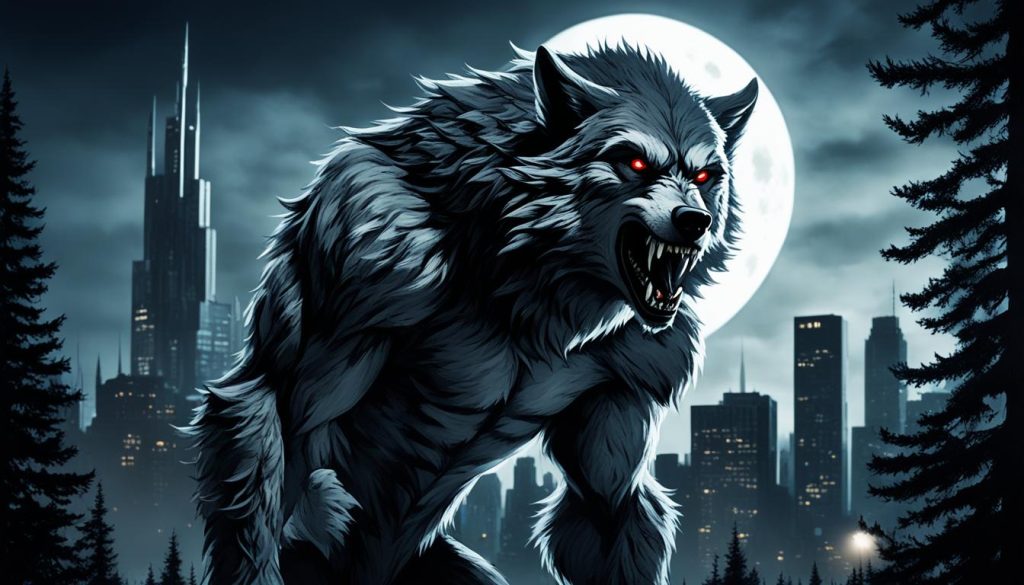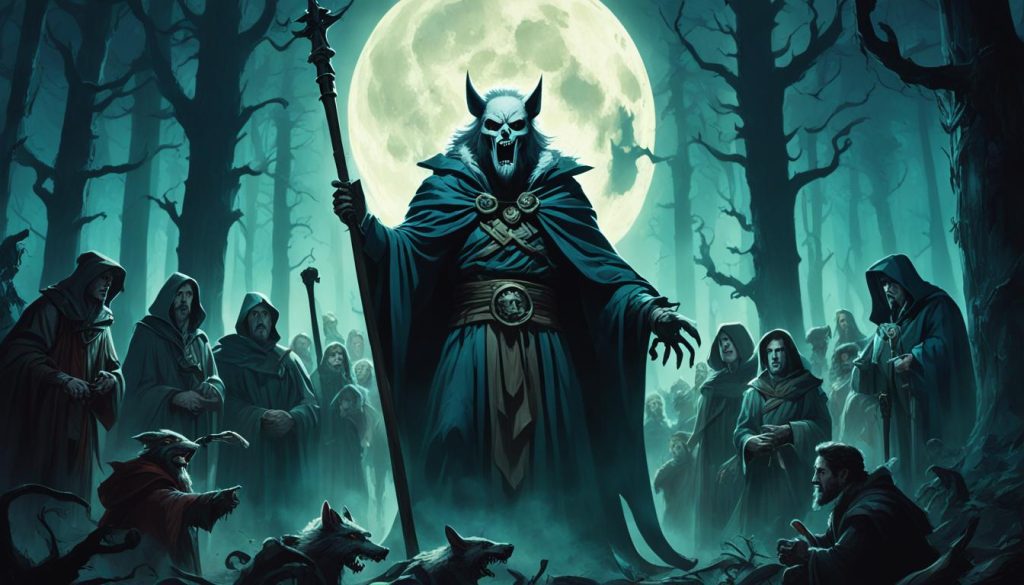Werewolves have fascinated people for thousands of years. Their mix of human and wolf has led to many stories of change, fear, and what makes us human. From old shamanic practices to today’s movies, werewolves keep showing us our deepest fears and interests. This deep dive will look at the werewolf’s story through history, myths, and popular culture.
Key Takeaways
- Werewolves have a rich history rooted in ancient folklore and mythology, transcending cultures and centuries.
- The werewolf archetype explores the duality of human nature, the primal instincts that lurk beneath the surface.
- Werewolf tales have evolved from shamanic rituals to Gothic fiction, reflecting the changing societal fears and fascinations.
- Werewolf mythology remains a captivating element of fantasy and the supernatural, continuing to inspire creative works across media.
- Exploring the werewolf’s journey provides insights into the human condition, the power of transformation, and the enduring allure of the imaginary.
The Shamanic Origins of Werewolf Lore
Ancient humans wore wolf pelts during shamanic rituals. These rituals helped them connect with the wolf’s wild energy. They were a way to enter a deep, primal state of mind.
The wolf was seen as a totemic animal. It was admired for its hunting skills, social life, and spiritual power. Shamans believed wearing wolf skins let them tap into the wolf’s strength and spirit through rituals.
Prehistoric Cave Paintings and Rituals
Prehistoric cave paintings show our ancient connection to wolves. They feature humans with wolf-like traits. This suggests early humans wanted a deep spiritual link with their spirit guides.
- Shamans likely used these rituals to gain the wolf’s hunting skills, social nature, and mystical powers.
- Turning into a wolf-like form was seen as a way to go beyond the physical world and meet the supernatural.
The Spiritual Significance of the Wolf
Throughout history, the wolf has been deeply spiritual. It’s linked with fantasy, power, and the mysterious. Shamans valued the wolf’s totemic traits. They wanted to use its strengths and connect with the primal forces of nature.
Lycanthropy in Greek and Roman Mythology
The stories of werewolves, or lycanthropy, go way back to ancient Greece and Rome. These myths gave the werewolf complex traits, mixing morality and fate. They made us think about what it means to change into something else and the choices we make.
The Tale of King Lycaon’s Transgression
King Lycaon is famous in Greek mythology for his werewolf story. He made a big mistake by eating Zeus a meal with human meat. Zeus turned him into a wolf, showing how serious the consequences of bad choices can be.
Arcadian Rituals and the Transformation Cycle
- In Roman mythology, werewolf stories were common, especially in Arcadia.
- One story is about Damarchus of Parrhasia, who turned into a wolf through an Arcadian ritual. After ten years of not eating human meat, he became human again, showing how one can be redeemed.
- These myths made us think about the limits of changing into something else, the power of choice, and our deep connection to wolves.
The fantasy of werewolves in Greek and Roman mythology told stories of wrongdoings, divine punishment, and the chance for redemption through change.
Medieval Werewolf Beliefs and Witch Trials
In medieval Europe, werewolves were more than just fantasy stories. They were a real concern for society. Kings made laws to protect people from these “madly audacious werewolves.” Scholars in churches talked about human-to-wolf transformations, exploring their meanings.
“Bisclavret” by Marie de France showed how humans and beasts are connected. The Úlfhednar warriors of Scandinavia showed the wolf’s strength in battle. As time went on, werewolves got mixed up in witch trials, seen as signs of the Devil’s work.
During this time, law and religion shaped how people saw werewolves. Medieval rulers tried to stop them, and scholars talked about their nature.
The link between werewolves and witch trials shows how deep fears and superstitions were. Werewolves became symbols of evil forces against society and faith. This led to many accusations, trials, and even death.
19th Century Gothic Fiction and Werewolves
In the 19th century, Gothic fiction became a popular genre. It used supernatural stories to show the deep sides of human nature. Works like George W.M. Reynolds’ “Wagner the Werewolf” and Bram Stoker’s “Dracula” featured werewolves prominently.
Reynolds’ Wagner the Werewolf
George W.M. Reynolds’ “Wagner the Werewolf” tells of an old man who deals with Dr. Faustus. He gets youth and wealth, but at the cost of becoming a werewolf. This story is a classic of 19th century Gothic fiction. It shows the fight between good and evil through the werewolf’s story.
Bram Stoker’s Dracula and Lycanthropy
Bram Stoker’s “Dracula” also explores lycanthropy. The main character can turn into a wolf with black magic. This famous Gothic fiction book made the werewolf a key part of literature. It uses the creature to look into the dark parts of our minds.
These 19th century Gothic fiction stories used werewolves to explore fantasy and human nature. They made the werewolf a lasting figure in Gothic literature.
Werewolves in Early Cinema
The world of cinema brought werewolf stories to life, making them a big part of popular culture. Two films, “Werewolf of London” and “The Wolf Man,” changed how we see werewolves forever.
Werewolf of London (1935)
“Werewolf of London” came out in 1935 and added new ideas to werewolf stories. It said werewolves could catch a disease, unlike the old stories. It also showed that werewolves are drawn to those they care about most.
The Wolf Man (1941) and the Full Moon Lore
“The Wolf Man” in 1941 made many werewolf ideas popular. It showed that silver can hurt werewolves, they change at night, and the full moon is key. These ideas have stuck with us, making the full moon a big part of werewolf stories.
These early werewolf movies had a big impact. They drew people in with exciting stories and helped create the werewolf myths we know today. They set the stage for how we see werewolves in movies and culture now.
The fantasy of Werewolves in Modern Culture
Werewolves have always fascinated us, long after the early movies. They continue to be a big part of fantasy and popular culture. They appear in everything from romance novels to horror stories, showing how much we love these shape-shifting beings.
Since classic movies like Werewolf of London and The Wolf Man, authors have made werewolves more diverse. They’ve added global traditions to the stories. Shows like Buffy the Vampire Slayer and True Blood have made werewolves even more interesting, showing how versatile they can be.
Today, werewolves are seen as romantic leads, detectives, or powerful enemies. They are a key part of fantasy, paranormal romance, urban fantasy, and horror. They show the endless creativity of the werewolf in modern culture.

The story of werewolves has changed over time. It now reflects what we find interesting today. The werewolf symbolizes the mix of human and animal in us. It shows the power of the wild side we all have.
Exploring Werewolf Mythology Across Cultures
The legend of the werewolf goes beyond old stories. It has its own special meanings in different cultures. From Norse mythology’s shapeshifting tales to ancient Germania’s fierce tribes, this myth has caught our imagination for ages.
Norse Shapeshifting Tales
Norse mythology is full of stories about changing into different forms. The Saga of the Volsungs tells us about heroes like Ulf who could turn into a wolf. This shows how important the wolf was in Scandinavian beliefs, linking to the gods and the supernatural.
Germanic Warrior Wolf Tribes
The Úlfhednar, a group of fierce warriors, are part of Norse werewolf stories. They wore wolf skins and fought like the animals. They were known for their strength, speed, and bravery, showing their deep connection to nature and their warrior culture.
These stories from different cultures show how much we all love the werewolf myth. It proves that fantasy and werewolf mythology are timeless. They remind us of the magic in Norse mythology, Scandinavia, and Germanic warrior tribes.
The Trials of Werewolf Accusations
In the early modern era, people believed in lycanthropy, or the idea that someone could turn into a wolf. This belief mixed with the witch trials, leading to many trials and executions in Europe. The werewolf was seen as a sign of sorcery and the Devil’s power.
The Case of Petter Stump
Petter Stump, a German farmer, was accused of many crimes like murder, cannibalism, incest, and sorcery. He was said to turn into a wolf. His story was shared in 16th-century Germany through pictures, making people very interested in werewolf trials.
Gilles Garnier, the Werewolf of Dôle
In France, Gilles Garnier faced a similar fate. He was found guilty and burned at the stake for his crimes. He used a magical ointment to become a wolf. Gilles’ trial shows how much fear and interest werewolves caused in people back then.

The stories of Petter Stump and Gilles Garnier show how fantasy, superstition, and law mixed in the early modern times. Werewolves were seen as symbols of dark forces that threatened society.
Conclusion
The fantasy of werewolves has caught our attention for centuries. It shows us our deepest human nature. From ancient shamanic rituals to today’s movies and books, the werewolf has changed. But its core remains, proving its lasting charm.
We’ve looked at the vast stories of werewolf lore from different times and places. It’s clear the werewolf’s story is about exploring our inner selves. It shows how we balance our two sides and the mysteries that keep us interested.
The mix of man and wolf is a strong symbol. It makes us think about our complex nature. Through the werewolf’s changes, we see our own human nature. We are always between being civilized and wild, rational and instinctual.